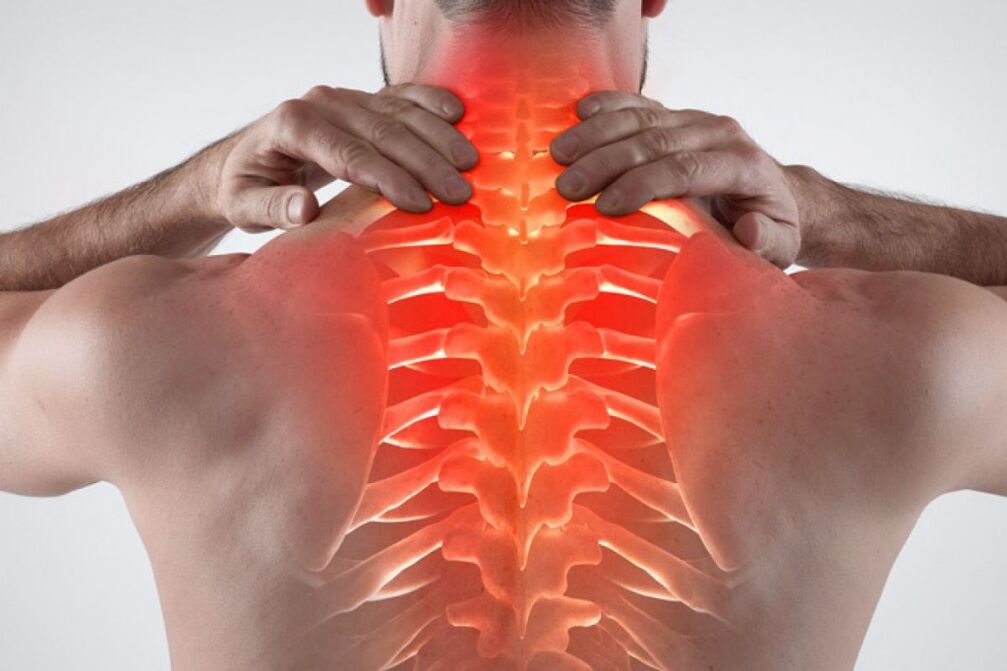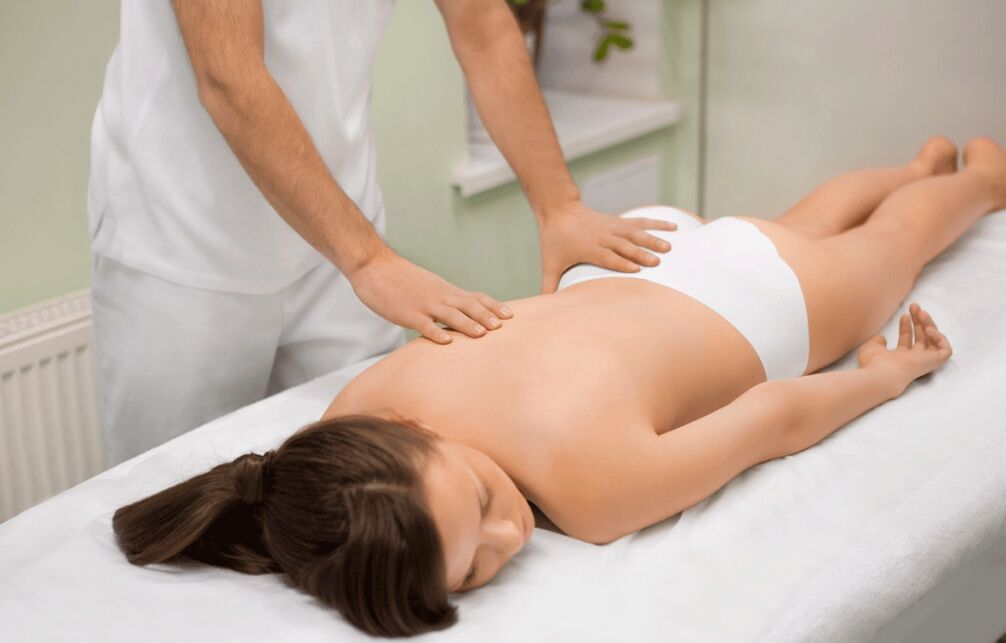
Thoracic osteochondrosis is a degenerative disease of the thoracic spine. First of all, the disease affects the intervertebral discs, causing back pain and unpleasant symptoms. Typical for this disease is also the premature "aging" of the cartilage tissue of the disc. Is.
Osteochondrosis can be diagnosed both in patients aged 20 years and in middle-aged patients.
This disease is less common than other forms of osteochondrosis - cervical and lumbar. This is explained by the reduced mobility of the thoracic region, as well as protection by the muscle corset and ribs.
There are 12 vertebrae in the thoracic region - from T1 to T12. Most often, the lower vertebrae are affected - T10, T11, T12.
Symptoms of thoracic osteochondrosis
Symptoms of osteochondrosis of the thoracic spine include:
- Pain in chest
- labored breathing
- Pain increases with deep breathing
- increased fatigue
- unsteady gait
- feeling of tightness in the chest area
- Bend
- shortness of breath
- Diffidence
- pain in esophagus
- cough
The pain caused by thoracic osteochondrosis is divided into dorsalgia or dorsalgia according to its characteristics.
Dorsago – sharp pain in the chest area. This occurs when one remains in the same position for a long time. The pain can make breathing difficult.
Dorsalgia is moderate pain in the area of the affected disc. The pain intensifies when taking a deep breath. The unpleasant sensations begin gradually.
Reasons for the development of thoracic osteochondrosis
The reasons for the occurrence and development of thoracic osteochondrosis are often related to the patient's lifestyle and uneven load on the spine. For example, people who spend a long time sitting are at risk: remote or office work at a computer, driving again and again.
A sedentary lifestyle disrupts the functioning of the circulatory and lymphatic systems, and insufficient exercise weakens muscle tissue. At the same time, sitting position increases the load on the spine.
The occurrence of thoracic osteochondrosis can also be influenced by previous spinal cord injuries, excess weight, and weakened immunity.
Osteochondrosis can also develop in women who frequently wear high heels or who are pregnant.
Exacerbation of thoracic osteochondrosis is possible from uncomfortable sleeping positions, smoking, attending poor-quality massage, or hypothermia.
Complications
Degenerative processes in the thoracic spine can lead to the development of the following pathologies:
- Spinal cord compression is compression of the spinal cord, causing loss of sensation in the abdomen, back, and chest.
- Kyphosis is the curvature of the spine.
- Bulging and herniation of the spine is a bulging of the center of the intervertebral disc, which affects the function of the pancreas and intestines.
- Intercostal neuralgia – intense pain in the intercostal space.
The organs affected by the complication depend on the affected vertebra.
Degree of development of thoracic osteochondrosis
- I degree - mild pain appears, which quickly resolves in a comfortable position. The intervertebral disc loses moisture, and the nucleus pulposus is slightly displaced. This stage is not always paid attention to, because the pain causes severe discomfort. Does not cause any symptoms and heals quickly.
- Second degree - cracks appear in the intervertebral discs, keeping the spine in a fixed position causes cramps, pain in the back and chest. The disc begins to lose its elasticity and its height begins to decrease. The muscles of the affected area become constantly tense. Are.
- III degree - protrusion of the central part of the intervertebral disc - the nucleus pulposus - occurs. This causes an intervertebral hernia. The pain becomes constant, and the cartilage begins to thin.
- IV degree – The tissue of the fibrous ring is replaced by bone. The bone tissue begins to break down.
Diagnosis of thoracic osteochondrosis
If you suspect osteochondrosis of the thoracic spine, you should contact a therapist or neurologist. During the examination, the patient talks about his complaints, and the doctor examines him physically. During the examination, the shoulder and pelvicAttention is paid to the relationship between waistband level, posture, chest size and condition of the muscular system.
Next, the doctor issues a referral for diagnostic tests. From the study, the patient can be determined:
- X-ray – X-rays are taken of problem areas of the spine, which show changes in the discs.
- CT scan - allows you to assess the condition of the lesion site and check the condition of the disc.
- An ECG is recommended if heart disease is suspected.
How to treat thoracic osteochondrosis
Conservative methods are used to treat osteochondrosis of the thoracic spine. They are aimed at eliminating pain, relieving spasms and normalizing blood circulation. These include:
- massage
- physical treatment
- physical treatment
- taking vitamins and medications
Massage for thoracic osteochondrosis

Massaging the cervicothoracic area will provide relief from pain and swelling, as well as strengthen the muscles that maintain the vertebrae in a stable position.
During the session, the following massage techniques are used: stroking, squeezing, kneading, rubbing and vibration. The direction of influence in osteochondrosis depends on the location of the lesion. Massage should be performed only by a specialist who knows how to make the procedure really effective. Special oils can be used while massaging for better results.
However, before attending a massage course, you must make sure that it is not contraindicated for the patient. To do this you should consult your doctor. The list of contraindications includes cardiovascular pathologies, elevated body temperature, tuberculosisand skin diseases.
physical treatment
Gymnastics for thoracic osteochondrosis includes a set of exercises to strengthen the muscles of the spine and form a strong muscle corset. In the early stages, gymnastics will help you avoid taking medications.
What effect does exercise therapy have on thoracic osteochondrosis?
- deep breathing gets it right
- correct posture is formed
- Reduces load on the spine
- The deep muscles of the back become less stiff
- thoracic mobility increases
Exercises for osteochondrosis of the thoracic spine
Before starting gymnastics, you need to warm up. This can warm up the muscles and prepare them for physical activity. To warm up, you can do twists, turns and twists of the limbs, torso, neck and pelvis. Can be used.
Here are some exercises that are suitable for the treatment of thoracic osteochondrosis:
- "Boat" - you need to lie on your stomach, stretch your arms above your head and keep your legs straight. In this position, you need to bend your chest - smoothly and simultaneously with your arms andRaise your legs.
- Shoulder Raises – While standing and keeping your arms relaxed along your body, you will lift each shoulder in turn.
- Lean on a chair - You need to sit on a chair so that your back is pressed tightly against the back. The hands should be lowered. In this position, you have to keep your hands behind your back while inhaling and bend backwards. As you exhale, you have to bend forward. You can also bend to the side.
- Back Arch – Standing on all fours, you need to arch your back and maintain this position for several seconds. Then you need to return to the starting position. It is advisable to perform the exercise on a special mat.
Exercises should be done regularly for several months. Therapeutic gymnastics should not last more than 30 minutes, and it should be done in comfortable shoes and clothing. If intense pain occurs, you must stop the exercises.
physical treatment
Physiotherapy is suitable for complex treatment. It can be used as additional or independent therapy. For thoracic osteochondrosis, the doctor may prescribe the following procedures:
- Magnetotherapy is the effect of a magnetic field on the affected area, which allows you to normalize blood circulation, restore affected tissues and improve the mobility of the lumbar region.
- Laser therapy is the effect of laser rays on the affected area. Helps improve immunity, provides analgesic and anti-inflammatory effects. There is no pain during the procedure.
- Shock wave therapy is exposure to infrasonic acoustic waves. They promote bone growth, stimulate collagen production and improve blood circulation.
- Medicinal electrophoresis is an effective technique for eliminating pain and improving nutrition of affected tissues. Electrodes and pads containing medicinal substances are applied to the patient's skin.
All these procedures will help relieve the unpleasant sensations of the symptoms of thoracic osteochondrosis.
%20and%20damaged%20(red)%20due%20to%20thoracic%20osteochondrosis.jpg)
Drug treatment of osteochondrosis
With drug treatment, the patient is often prescribed a complex of drugs. Depending on the clinical manifestations of osteochondrosis the doctor determines the duration of the course and the list of specific drugs. The list of drugs includes, for example, anti-inflammatory drugs, muscleMay include relaxing medications, vitamins, as well as special ointments or gels.
Nutrition for thoracic osteochondrosis
As an additional treatment measure, the patient may be prescribed the "Table No. 15" diet. The diet does not require giving up most of the popular foods, but its peculiarity lies in the diet with a high content of vitamins.
As part of the diet you can eat:
- Bread
- Milk
- Soup
- Lean meat – it is recommended to eat it daily
- Pasta
- Vegetables – both fresh and in salads or cooked
- eggs
- fresh fruit
- fresh berries
- variety of sweets
- Butter and Vegetable Oil
Permitted drinks include weak coffee, tea, juice and kvass.
What not to eat:
- Puff Pastry Pastry
- fatty meat or fish dishes
- chocolate products
As far as beverages go, drinking strong coffee, strong tea or alcoholic beverages is not recommended.
Prevention of thoracic osteochondrosis
Recommended preventive measures include:
- swimming or other water sports
- Do regular warm up when working on computer for a long time
- Maintain sitting position – back should be straight and shoulders should be straight
- Avoiding back hypothermia
- regular exercise therapy
Also, attention should be paid to the choice of bedding. An unsuitable mattress and pillow will prevent your back and neck from relaxing while sleeping. For this reason, it is recommended to purchase special orthopedic accessories for a comfortable stay with osteochondrosis.

















































